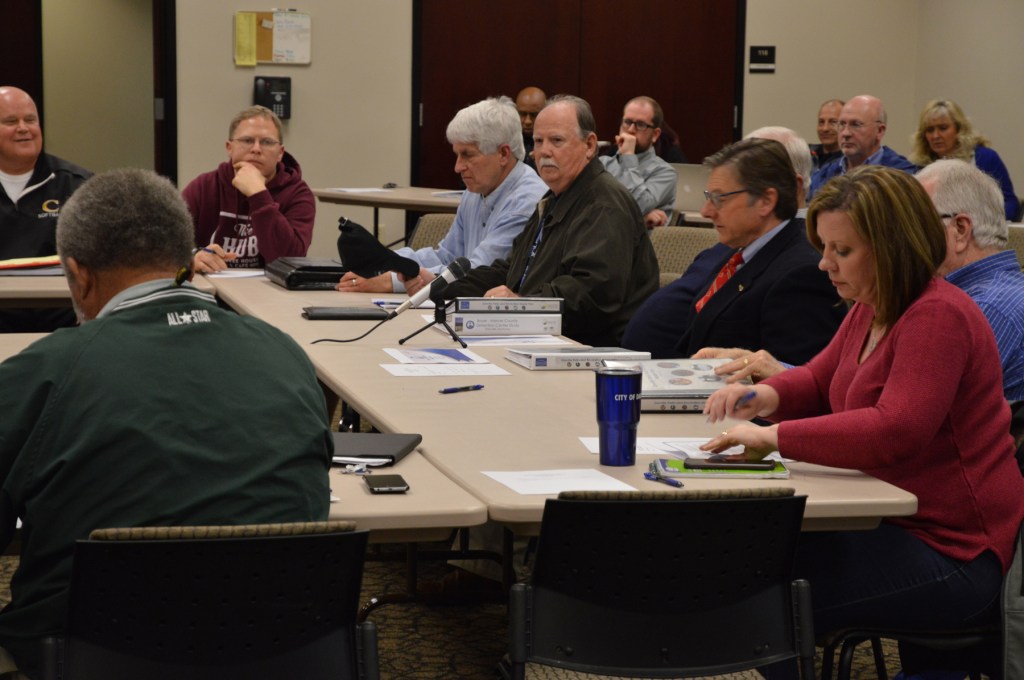Danville, Boyle form Parks & Rec working group
Published 8:35 pm Tuesday, February 5, 2019

- Photo by Bobbie Curd Danville and Boyle officials meet in a joint effort to discuss the results of the Parks & Rec master plan on Monday. About 25 other people were in attendance, as well.
A new working group is being created to address parks and recreation needs in Danville and Boyle County, but what exactly it will do isn’t yet clear.
The working group was voted into existence Monday, during a two-hour joint meeting between Danville City Commission and Boyle County Fiscal Court, called to address how to handle the findings and recommendations of the city’s recently completed parks master plan.

Photo by Bobbie Curd
City Manager Ron Scott, left, puts an arm around Magistrate Phil Sammons after a joke was made about Sammons sitting on the city-side of the table during the joint meeting.
Judge-Executive Howard Hunt made the motion that two members each from Danville City Commission and Boyle County Fiscal Court, plus one member from the Danville-Boyle County Parks & Rec Board make up the working group. Many commented on confusion of why another committee — or “working group” — needed to be formed when there is a Parks & Rec board, as well as a former ad hoc committee, but all voted in favor of the move — except Commissioner J.H. Atkins.
Trending
Tuesday, Atkins said he voted against forming the working group because there had already been an ad hoc committee with seven members.
“We had city and county representation on that, and on the Parks & Rec board. To me, that’s been in place and was already working and did some successful things. Not sure why we’d create something new and start all over again,” Atkins said. “Now, we’re going to have a five-member committee. My thought is if we’re going to keep the Parks & Rec board, let’s expand it and let them do their work.”
Boyle County Fiscal Court members often framed discussions about parks issues within a bigger issue they’re dealing with: the need for a new or renovated jail that could cost tens of millions of dollars.
The master plan is the result more than a year-long study by the firm Brandstetter & Carroll. The consultants’ findings are compiled in a lengthy report detailing the policies and procedures governing Parks & Rec and its programs, the upkeep of the parks, and information gathered from a citizen survey and other groups. The meeting was facilitated by Monica Sumner, creative director and VP of Brandstetter, who is also a local resident.
Sumner presented of a condensed version of the master plan, highlighting the major goals and objectives to be discussed in the joint meeting, along with a list of recommendations.
Sumner said information collected reflected “a desire to foster public involvement and teamwork … and leadership. It is noted here … the group is not satisfied with the status quo at this time” and wants “to have stronger leaders in the community” who oversee the system.

Photo by Bobbie Curd
Monica Sumner, with Brandstetter Carroll, facilitates the joint meeting between Danville City Commission and Boyle County Fiscal Court held Monday to discuss the Parks & Rec master plan.
Trending
She said, “This is where things get real — the goals developed out of the work.” They included more modern, family-friendly facilities inside parks, more locations for sports and better land management. “Improved connectivity” with nature and trails fell in this category, as well as more “exciting programs” and events, such as outdoor concerts and more events for “users of all ages and abilities.”
The need for more effective management and operations was a top-listed goal, specifically “proactive management of staff and finances to promote an informed population.” Sumner said this is “a big one” and listed the objectives behind it, such as “unity, finances, customer service, workforce, engagement, collaboration and maintenance.”
As far as specific recommendations, Sumner said although each park examined has “very distinct and specific” needs, like fence repairs or more picnic tables, she narrowed in on overall system changes in order to have a broader and more efficient discussion for the joint meeting.
Administering a single department to oversee the system from a central location inside of a park to improve coordination purposes was No. 1, and the second was hiring a director — which has been an ongoing process since August.
Others high on the list were expanding maintenance staff and programs, implementing online registration, “increasing capital and operating budgets to be more in line with other communities” and developing an outdoor aquatic center.
Sumner said the firm received a “great deal of citizen participation” in gathering its data from an online survey, to community stakeholder meetings and postcards collected at events and during multiple meetings.
After the floor opened up for discussion, Magistrate Jamey Gay called the gathering a sign “of a new day dawning in Danville and Boyle County with a great working relationship between our city and county government.” However, he added “I would be remiss if I didn’t say I was disappointed … that the previous fiscal court did not participate in the development of this document.”
“It’s not too late,” Mayor Mike Perros said.
Gay said the parks system should be a “county-wide endeavor” that should include all three incorporated cities of Danville, Perryville and Junction City. He said it should start by “reinvesting in the parks we have and working to properly maintain them …”
Magistrate Tom Ellis took the mic and said western Boyle County “represents probably 55+ percent of the geography” of the county, and that it’s critical they look at these areas, including Forkland. He said the commemoration event at Perryville Battlefield a few years back brought many people into the area.
Perryville Battlefield and the Central Kentucky Wildlife Refuge both have their own management in place and are not under the auspices of Parks & Rec.
“I know these are opportunities separate from city and county park systems, but if we’re truly talking about drawing in tourism — the first year I lived here commemorated a major time for the battlefield … and I would hope that if we do an addendum to this, we would mention that it was such an extraordinary event … Forkland is its own jewel in western Boyle County with extraordinary festival,” Ellis said, relating his comments to the connectivity goals. He touted nature preserves in Forkland and said “if we want to draw people in from other states who truly enjoy trails, then bring them out to that nature preserves.”
A citizen in the audience asked if they had plans to reopen the city pool at Bunny Davis this year.
Magistrate Gay said he didn’t know what the city’s plans are, but that he’s always believed “with some modifications, it’s still a very functionable and working facility. I would urge us to think through the aquatic center.” He said while an aquatic center will always be on wish lists, they are difficult and expensive to maintain, and splash parks may be the answer.

Photo by Bobbie Curd
Commissioners J.H. Atkins, left, and Kevin Caudill participate in the joint meeting held Monday to discuss moving forward on the Parks & Rec master plan.
Municipal Utility Engineer Earl Coffey said the goal is to get the Bunny Davis pool reopened.
Magistrate John Caywood said, “This is all good information, but one of the first things that jumped out to me” is the single governmental department issue. He asked Sumner if that recommendation is what’s seen in other communities, and asked about the thinking behind it.
Sumner said yes, it’s what’s mostly seen, and the philosophy is a “very simple concept,” relating it to “how many cooks you have in the kitchen.” She said whether it’s a joint board or a single unit of local government, it needs to be “one source that controls the entity.”
Sumner said in this case, there is a joint board that the county and city support, “however we haven’t seen a tremendous amount of effectiveness in getting things done each year that local government would like to see.”
Caywood asked if she saw the lack of effectiveness as due to money or the structure; Sumner said structure.
“In any type of public project … everyone likes to think that money is the problem … but really it comes down to the want-to, the leadership, the effort and work to get something done,” she said. “We find the money for what we need to do, for what’s important to our family.”
Magistrate Jason Cullen said he disagrees with Gay’s assertions that focus should be kept only on what the county already had. He said on the county level, the big issue is spending up to $40 million on a new jail “that the majority of the people in this county will never utilize, but their tax dollars are going for it.”
“So am I for spending a lot of money on an aquatic center? No, we can find ways to come up with stuff, whether it be a private or public partnership … That’s useful to talk about.”
Cullen said he realizes spending an estimated $3 million-$5 million on an aquatic center seems like a lot, “but that’s 10 to 15 percent of what we’re going to possibly have to spend on this new jail, whether we fix up the one we have or build a new one.”
He said when his family relocated to Danville, “the thing that always upset me as a citizen and as a business owner, my wife and children would utilize outside counties’ aquatic centers and recreation facilities during the summertime instead of utilizing what we have here, because what we have here is outdated.”

Photo by Bobbie Curd
Resident Steve Cline, center, asks officials questions at the joint meeting about Parks & Rec Monday about why the government would need to fund a multi-million dollar aquatic center. The center is one of the responses Brandstetter Carroll repeatedly received as a wish-list item from area residents.
Those who chose to go to other communities to use more updated facilities also spend their money while in the communities, he said.
“We tried Bunny Davis. The first year here, we went twice,” he said. “And that was it. We chose to go elsewhere, so while it fits for a portion of our town, it doesn’t do what it should do.”
Judge-Executive Hunt took to the front podium and brought up again how he heard a lot of citizens saying they’d like to see the city and county work together more, and how the group coming together was as close as it gets, using the “new day” analogy.
“Brandstetter Carroll did an excellent job on this Parks & Recreation master plan. Coincidentally, they did an excellent job on the Boyle and Mercer County detention center study. Now, we’ve heard some of the recommendations in the master plan. But what I’d like to see is the … two bodies come together and zero in on their respective focuses, and through collaboration and small work groups … make some recommendations how we can collectively help the city realize the fullness of its vision with parks and recreation, and how we can … help the county further the effectiveness of the detention center.”
Hunt feels both issues are related due to “public safety being one of the primary issues of government service …”
He said the jail plan recommended a $30 million-$40 million to replace the jail, or less to bring it into compliance. Hunt said as a fiscal conservative, he’d like to explore every opportunity to solve the issue more cheaply, if possible.
“That’s the main crux of this meeting, is to bring all the collective synergy, energy, understanding and communications of both parties to help further what’s best for Boyle County, in all respects.”
The topic of the detention center was not on the agenda for the joint meeting.
Hunt said he’d like a small working group appointed to “prepare a presentation on agreed-upon findings to the commission and the court” on how to achieve this, and wants to appoint Magistrates Phil Sammons and Ellis because they are “committee representation from both the detention center and Parks & Rec,” and whoever the city wants to appoint. He said the director position and open Parks & Rec board appointments should not be delayed, then turned back to the detention center.
“We have some real monster issues facing the detention center — ‘costly’ is an understatement,” Hunt said.
Commissioner J.H. Atkins needed clarification. “You’ve put the jail situation in with the Parks & Rec situation … is this committee, or working group, going deal with Parks & Rec?”
“It is, it is,” Hunt said. “I think there may be some opportunities through examination … to see where we have a resource, asset, some process that may be able to help you and vice versa with our detention center … “
Atkins said he was still confused, since there is a Parks & Rec Board, and there is a joint jail committee, and asked if the “new, small working group would be working in conjunction with them, or separate from them?”
Hunt said, “I would assume not separate from, but in conjunction with …”
Atkins pointed to the fact there is city and county representation on the Parks & Rec board, but no city representation on the joint jail committee.
As far as the aquatic center discussion, Atkins said it should be an indoor and outdoor center, so it can be utilized all year around.
Magistrate Gay said he feels the area is a “relatively small market” for such a center, and big-ticket items need to be thought out well.
Magistrate Sammons said Gay had some good points, “but we’re talking about things that we don’t need to be discussing right now … You’ve got the wish list … I think we need to decide in the next meeting what we really want to do, then we’ll discuss the needs and wants, OK?”

Photo by Bobbie Curd
Commissioner Rick Serres responds participates in the joint meeting held Monday between the city and county, aimed at discussing the Parks & Rec master plan.
One resident questioned the validity of the study’s findings on public opinion and whether enough people had been polled to create reliable findings.
Cullen said around 500 to 600 people were surveyed for the study.
“If you look at our last election only 10,000 people voted out of 30,000,” he said. “So does that make our election null and void? No. We can’t force people to come out and do things, but we have to listen to those who have actually come out and voiced their opinion.”
Magistrate Caywood questioned how the “working group” would be different from the Parks & Rec ad hoc group that has been in operation. “We’ve got a committee that’s formed that’s very close to what you’re talking about, we may not have to reinvent the wheel …”
Hunt said the ad hoc committee could “fit fine … but if we’re looking at it from a county point of view, I want to make sure the detention center interests are at least considered throughout the fact finding.”
City Manager Ron Scott’s suggestion was to consider that the clock is ticking, and whatever is formed needs to come to quick conclusions in order to get park programs up and rolling.
“There needs to be clarity over what sort of administration (a new director) will be working under … the whole issue of a future aquatic center is several years down the road,” Scott said.
He said the group’s primary needs are much more immediate, in terms of getting programs underway for Parks & Rec, reaching an agreement on how to fund the operation and who will administer it.
He said in his opinion, if that conversation is opened up to an even wider group of people, like a working group, “you’re not necessarily going to get a quick conclusion.”
Commissioner Denise Terry said it has already been proven by the ad hoc committee that it just “adds another layer and a lot of confusion.”
Terry also said that while studies show recreational activities do keep kids out of jail, she doesn’t believe the city “should or would engage in a conversation about the jail. I don’t think that’s appropriate.”
Terry said they were there to have an open dialogue, and “our first decision is who’s going to take the lead on this.”
Mayor Perros said city government is a service organization and recreation is part of what it is expected to provide. The county and state are responsible for the jail, and the city is responsible for services, such as recreational activities, he said.






